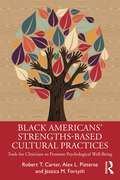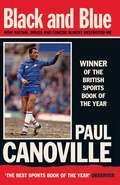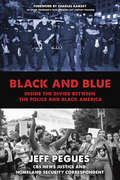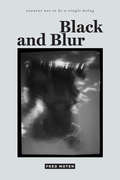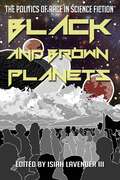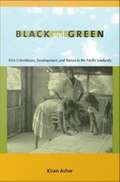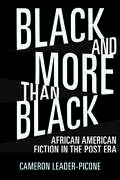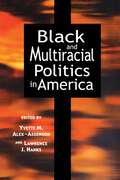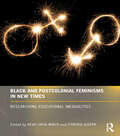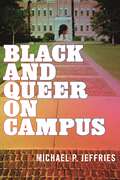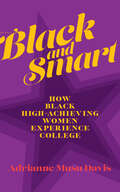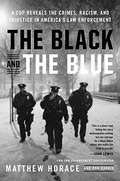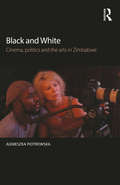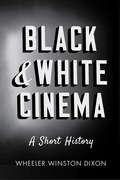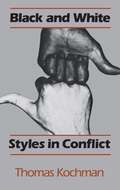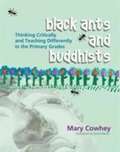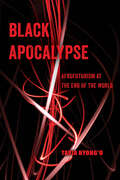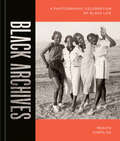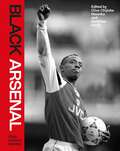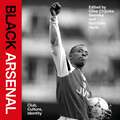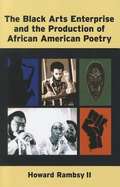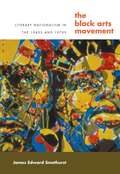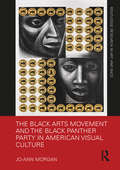- Table View
- List View
Black American’s Strengths-Based Cultural Practices: Tools for Clinicians to Promote Psychological Well-Being
by null Robert T. Carter null Alex Pieterse null Jessica ForsythBlack Americans' Strengths-Based Cultural Practices: Tools for Clinicians to Promote Psychological Well-Being uses historical, social, scientific, and psychological research to detail how mental health professionals can use the cultural practices of Black Americans and communities to promote positive psychosocial health.Building on experiences of racial oppression and cultural values, Dr’s. Carter, Pieterse, and Forsyth offer an evidence-based framework for recognizing and enhancing strengths-based cultural practices of Black American clients and families in mental health interventions. This volume will broaden the base of work on the mental health treatment of Black Americans and provide an approach to understanding the unique cultural influences of Black people as they relate to psychological health.The book is suitable for a wide range of professionals, including social workers, mental health practitioners, nurses, teachers and sociologists at various levels of education and training.
Black and Blue: How Racism, Drugs and Cancer Almost Destroyed Me
by Paul CanovillePaul Canovilles story is one of extreme racist bigotry, shattering career-ending injury, a decline into drug abuse, battles against cancer, family tragedy and a determination to beat the odds. Canoville was Chelsea's first black first-team player, making his debut in 1982. But as he warmed up on the touchline, his own supporters began chanting 'We don't want the nigger!' The racist bile continued whenever he played, but within a year he had won over the terraces with his explosive pace and skill. Canoville fell out with the Chelsea board and moved to Reading in 1986, where injury suddenly ended his career at the age of 24. This started a downward spiral including the death of his baby in his arms, two bouts of life-threatening lymph cancer, drug abuse and homelessness. But Canoville fought back. In this explosive and shocking story, Paul finally explains why, despite everything, he is more positive than ever and has remained a fervent Chelsea fan all his life. This is a story of hope - eventually - overcoming adversity.
Black and Blue
by John HobermanBlack & Blue is the first systematic description of how American doctors think about racial differences and how this kind of thinking affects the treatment of their black patients. The standard studies of medical racism examine past medical abuses of black people and do not address the racially motivated thinking and behaviors of physicians practicing medicine today. Black & Blue penetrates the physician's private sphere where racial fantasies and misinformation distort diagnoses and treatments. Doctors have always absorbed the racial stereotypes and folkloric beliefs about racial differences that permeate the general population. Within the world of medicine this racial folklore has infiltrated all of the medical sub-disciplines, from cardiology to gynecology to psychiatry. Doctors have thus imposed white or black racial identities upon every organ system of the human body, along with racial interpretations of black children, the black elderly, the black athlete, black musicality, black pain thresholds, and other aspects of black minds and bodies. The American medical establishment does not readily absorb either historical or current information about medical racism. For this reason, racial enlightenment will not reach medical schools until the current race-aversive curricula include new historical and sociological perspectives.
Black and Blue: Inside the Divide between the Police and Black America
by Jeff PeguesThe recent killings in Dallas, Baton Rouge, Ferguson, and elsewhere are just the latest examples of the longstanding rift between law enforcement and people of color. In this revealing journey to the heart of a growing crisis, CBS News Justice and Homeland Security Correspondent Jeff Pegues provides unbiased facts, statistics, and perspectives from both sides of the community-police divide. Pegues has rare access to top law enforcement officials throughout the country, including FBI Director James Comey and police chiefs in major cities. He has also interviewed police union leaders, community activists, and others at the heart of this crisis--people on both sides who are trying to push American law enforcement in a new direction. How do police officers perceive the people of color who live in high-crime areas? How are they viewed by the communities that they police? Pegues explores these questions and more through interviews not only with police chiefs, but also officers on the ground, both black and white. In addition, he goes to the front lines of the debate as crime spikes in some of the nation's major cities. What he found will surprise you as police give a candid look at how their jobs have changed and become more dangerous.Turning to possible solutions, the author summarizes the best recommendations from police chiefs, politicians, and activists. Readers will not only be informed but learn what they can do about tensions with police in their communities.From the Hardcover edition.
Black and Blur
by Fred Moten"Taken as a trilogy, consent not to be a single being is a monumental accomplishment: a brilliant theoretical intervention that might be best described as a powerful case for blackness as a category of analysis."—Brent Hayes Edwards, author of Epistrophies: Jazz and the Literary Imagination In Black and Blur—the first volume in his sublime and compelling trilogy consent not to be a single being—Fred Moten engages in a capacious consideration of the place and force of blackness in African diaspora arts, politics, and life. In these interrelated essays, Moten attends to entanglement, the blurring of borders, and other practices that trouble notions of self-determination and sovereignty within political and aesthetic realms. Black and Blur is marked by unlikely juxtapositions: Althusser informs analyses of rappers Pras and Ol' Dirty Bastard; Shakespeare encounters Stokely Carmichael; thinkers like Kant, Adorno, and José Esteban Muñoz and artists and musicians including Thornton Dial and Cecil Taylor play off each other. Moten holds that blackness encompasses a range of social, aesthetic, and theoretical insurgencies that respond to a shared modernity founded upon the sociological catastrophe of the transatlantic slave trade and settler colonialism. In so doing, he unsettles normative ways of reading, hearing, and seeing, thereby reordering the senses to create new means of knowing.
Black and Brown Planets: The Politics of Race in Science Fiction
by Isiah Lavender IIIBlack and Brown Planets embarks on a timely exploration of the American obsession with color in its look at the sometimes-contrary intersections of politics and race in science fiction. The contributors, including De Witt D. Kilgore, Edward James, Lisa Yaszek, and Marleen S. Barr, among others, explore science fiction worlds of possibility (literature, television, and film), lifting blacks, Latin Americans, and indigenous peoples out from the background of this historically white genre. This collection considers the role of race and ethnicity in our visions of the future. The first section emphasizes the political elements of black identity portrayed in science fiction from black America to the vast reaches of interstellar space framed by racial history. In the next section, analysis of indigenous science fiction addresses the effects of colonization, helps discard the emotional and psychological baggage carried from its impact, and recovers ancestral traditions in order to adapt in a post-Native-apocalyptic world. Likewise, this section explores the affinity between science fiction and subjectivity in Latin American cultures from the role of science and industrialization to the effects of being in and moving between two cultures. By infusing more color in this otherwise monochrome genre, Black and Brown Planets imagines alternate racial galaxies with viable political futures in which people of color determine human destiny.
Black and Green: Afro-Colombians, Development, and Nature in the Pacific Lowlands
by Kiran AsherIn Black and Green, Kiran Asher provides a powerful framework for reconceptualizing the relationship between neoliberal development and social movements. Moving beyond the notion that development is a hegemonic, homogenizing force that victimizes local communities, Asher argues that development processes and social movements shape each other in uneven and paradoxical ways. She bases her argument on ethnographic analysis of the black social movements that emerged from and interacted with political and economic changes in Colombia's Pacific lowlands, or Choc region, in the 1990s. The Pacific region had yet to be overrun by drug traffickers, guerrillas, and paramilitary forces in the early 1990s. It was better known as the largest area of black culture in the country (90 percent of the region's population is Afro-Colombian) and as a supplier of natural resources, including timber, gold, platinum, and silver. Colombia's Law 70, passed in 1993, promised ethnic and cultural rights, collective land ownership, and socioeconomic development to Afro-Colombian communities. At the same time that various constituencies sought to interpret and implement Law 70, the state was moving ahead with large-scale development initiatives intended to modernize the economically backward coastal lowlands. Meanwhile national and international conservation organizations were attempting to protect the region's rich biodiversity. Asher explores this juxtaposition of black rights, economic development, and conservation--and the tensions it catalyzed. She analyzes the meanings attached to "culture," "nature," and "development" by the Colombian state and Afro-Colombian social movements, including women's groups. In so doing, she shows that the appropriation of development and conservation discourses by the social movements had a paradoxical effect. It legitimized the presence of state, development, and conservation agencies in the Pacific region even as it influenced those agencies' visions and plans.
Black and More than Black: African American Fiction in the Post Era (Margaret Walker Alexander Series in African American Studies)
by Cameron Leader-PiconeCHOICE Outstanding Academic Title for 2020Post-Blackness. Post-Soul. Post-Black Art. New Blackness. How has the meaning of blackness changed in the twenty-first century? Cameron Leader-Picone suggests that this proliferation of terms, along with the renewed focus on questioning the relationship between individual black artists and the larger black community, indicates the arrival of novel forms of black identity and black art. Leader-Picone defines these terms as significant facets of a larger post era, linking them with the social and political context of Barack Obama’s presidency. Analyzing claims of progress associated with Obama’s election and post-era thinking, he examines the contours of black aesthetics in the new century. To do so, he sifts through post-era African American fiction, considering both celebrations and rejections of an early twenty-first-century rhetoric of progress. In addition, he maps the subsequent implications of these concepts for rearticulating racial identities. Through the works of Colson Whitehead, Alice Randall, Chimamanda Ngozi Adichie, Paul Beatty, Kiese Laymon, and Jesmyn Ward, Leader-Picone tracks how recent fiction manifests the tension between the embrace of post–civil rights era gains and the recognition of persistent structural racism. Ultimately far less triumphal than the prefix post would imply, these authors address the Black Arts Movement and revise double consciousness and other key themes from the African American literary tradition. They interrogate their relevance in an era encompassing not only the election of the nation’s first black president, but also the government’s failed response to Hurricane Katrina, the expansion of class divisions within the black community, mass incarceration, and ongoing police violence.
Black and Multiracial Politics in America
by Yvette M. Alex-Assensoh Lawrence J. HanksAmerica is currently in the midst of a major racial and ethnic demographic shift. By the twenty-first century, the population of Hispanics and Asians will increase significantly, while the black population is expected to remain relatively stable. Non-Hispanic Whites will decrease to just over half of the nation's population. How will the changing ethnic and racial composition of American society affect the long struggle for black political power and inclusion? To what extent will these racial and ethnic shifts affect the already tenuous nature of racial politics in American society? Using the literature on black politics as an analytical springboard, Black and Multiracial Politics in America brings together a broad demography of scholars from various racial and ethnic groups to assess how urban political institutions, political coalitions, group identity, media portrayal of minorities, racial consciousness, support for affirmative action policy, political behavior, partisanship, and other crucial issues are impacted by America's multiracial landscape. Contributors include Dianne Pinderhughes, M. Margaret Conway, Pei-te Lein, Susan Howell, Mack Jones, Brigitte L. Nacos, Natasha Hritzuk, Marion Orr, Michael Jones-Correa, A.B. Assensoh, Joseph McCormick, Sekou Franklin, Jose Cruz, Erroll Henderson, Mamie Locke, Reuel Rogers, James Endersby, Charles Menifield and Lawrence J. Hanks.
Black and Postcolonial Feminisms in New Times: Researching Educational Inequalities
by Heidi Safia Mirza Cynthia JosephThis book is a compelling collection of essays on the intersection of race, gender and class in education written by leading black and postcolonial feminists of colour from Asia, Africa and the Caribbean living in Britain, America, Canada, and Australia. It addresses controversial issues such as racism in the media, exclusion in higher education, and critical multiculturalism in schools. Introducing new debates on transglobal female identity and cultures of resistance the book asks: How does black and postcolonial feminisms illuminate race and gender identity in new global times? How are race, gender and class inequalities reproduced and resisted in educational sites? How do women of colour experience race and gender differences in schools and universities? This book is a must for political and social commentators, academic researchers and student audiences interested in new feminist visions for new global times.This book was published as a special issue of Race, Ethnicity and Education.
Black and Queer on Campus
by Michael P. JeffriesAn inside look at Black LGBTQ college students and their experiences Black and Queer on Campus offers an inside look at what life is like for LGBTQ college students on campuses across the United States. Michael P. Jeffries shows that Black and queer college students often struggle to find safe spaces and a sense of belonging when they arrive on campus at both predominantly white institutions and historically black colleges and universities. Many report that in predominantly white queer social spaces, they feel unwelcome and pressured to temper their criticisms of racism amongst their white peers. Conversely, in predominantly straight Black social spaces, they feel ignored or pressured to minimize their queer identity in order to be accepted. This fraught dynamic has an impact on Black LGBTQ students in higher education, as they experience different forms of marginalization at the intersection of their race, gender, and sexuality.Drawing on interviews with students from over a dozen colleges, Jeffries provides a new, much-needed perspective on the specific challenges Black LGBTQ students face and the ways they overcome them. We learn through these intimate portraits that despite the gains of the LGBTQ rights movement, many of the most harmful stereotypes and threats to black queer safety continue to haunt this generation of students. We also learn how students build queer identities. The traditional narrative of “coming out” does not fit most of these students, rather, Jeffries describes a more gradual transition to queer acceptance and pride.Black and Queer on Campus sheds light on the oft-hidden lives of Black LGBTQ students, and how educational institutions can better serve them. It also highlights the quiet beauty and joy of Black queer social life, and the bonds of friendship that sustain the students and fuel their imagination.
Black and Smart: How Black High-Achieving Women Experience College (The American Campus)
by Adrianne Musu DavisEven academically talented students face challenges in college. For high-achieving Black women, their racial, gender, and academic identities intensify those issues. Inside the classroom, they are spotlighted and feel forced to be representatives for their identity groups. In campus life, they are isolated and face microaggressions from peers. Using intersectionality as a theoretical framework, Davis addresses the significance of the various identities of high-achieving Black women in college individually and collectively, revealing the ways institutional oppression functions at historically white institutions and in social interactions on and off campus. Based on interviews with collegiate Black women in honors communities, Black and Smart analyzes the experiences of academically talented Black undergraduate women navigating their social and academic lives at urban historically white institutions and offers strategies for creating more inclusive academic and social environments for talented undergraduates.
The Black and the Blue: A Cop Reveals the Crimes, Racism, and Injustice in America's Law Enforcement
by Matthew Horace Ron HarrisCNN contributor offers a searing indictment of America's law enforcement."This is a must-read.... Telling this story demonstrates nothing but raw courage for a black police officer who wants the truth to prevail." --John Lewis"[T]his [is a] hard-hitting, convincing indictment of the biases in today's law enforcement.... A must-read for anyone interested in understanding and solving these problems." --Booklist (starred review)Matthew Horace was an officer at the federal, state, and local level for 28 years working in every state in the country. Yet it was after seven years of service when Horace found himself face-down on the ground with a gun pointed at his head by a white fellow officer, that he fully understood the racism seething within America's police departments. Using gut-wrenching reportage, on-the-ground research, and personal accounts garnered by interviews with police and government officials around the country, Horace presents an insider's examination of police tactics, which he concludes is an "archaic system" built on "toxic brotherhood." Horace dissects some of the nation's most highly publicized police shootings and communities highlighted in the Black Lives Matter movement and beyond to explain how these systems and tactics have had detrimental outcomes to the people they serve. Horace provides fresh analysis on communities experiencing the high killing and imprisonment rates due to racist policing such as Ferguson, New Orleans, Baltimore, and Chicago from a law enforcement point of view and uncovers what has sown the seeds of violence.Timely and provocative, The Black and The Blue sheds light on what truly goes on behind the blue line.
Black and White: Cinema, politics and the arts in Zimbabwe
by Agnieszka PiotrowskaIn Black and White Agnieszka Piotrowska presents a unique insight into the contemporary arts scene in Zimbabwe – an area that has received very limited coverage in research and the media. The book combines theory with literature, film, politics and culture and takes a psychosocial and psychoanalytic perspective to achieve a truly interdisciplinary analysis. Piotrowska focuses in particular on the Harare International Festival of the Arts (HIFA) as well as the cinema, featuring the work of Rumbi Katedza and Joe Njagu. Her personal experience of time spent in Harare, working in collaborative relationships with Zimbabwean artists and filmmakers, informs the book throughout. It features examples of their creative work on the ground and examines the impact it has had on the community and the local media. Piotrowska uses her experiences to analyse concepts of trauma and post-colonialism in Zimbabwe and interrogates her position as a stranger there, questioning patriarchal notions of belonging and authority. Black and White also presents a different perspective on convergences in the work of Doris Lessing and iconic Zimbabwean writer Dambudzo Marechera, and how it might be relevant to contemporary race relations. Black and White will be intriguing reading for psychoanalysts, psychotherapists and psychotherapeutically engaged scholars, film makers, academics and students of post-colonial studies, film studies, cultural studies, psychosocial studies and applied philosophy.
Black and White Cinema
by Wheeler Winston DixonFrom the glossy monochrome of the classic Hollywood romance, to the gritty greyscale of the gangster picture, to film noir's moody interplay of light and shadow, black-and-white cinematography has been used to create a remarkably wide array of tones. Yet today, with black-and-white film stock nearly impossible to find, these cinematographic techniques are virtually extinct, and filmgoers' appreciation of them is similarly waning. Black and White Cinema is the first study to consider the use of black-and-white as an art form in its own right, providing a comprehensive and global overview of the era when it flourished, from the 1900s to the 1960s. Acclaimed film scholar Wheeler Winston Dixon introduces us to the masters of this art, discussing the signature styles and technical innovations of award-winning cinematographers like James Wong Howe, Gregg Toland, Freddie Francis, and Sven Nykvist. Giving us a unique glimpse behind the scenes, Dixon also reveals the creative teams--from lighting technicians to matte painters--whose work profoundly shaped the look of black-and-white cinema. More than just a study of film history, this book is a rallying cry, meant to inspire a love for the artistry of black-and-white film, so that we might work to preserve this important part of our cinematic heritage. Lavishly illustrated with more than forty on-the-set stills, Black and White Cinema provides a vivid and illuminating look at a creatively vital era.
Black and White Styles in Conflict
by Thomas Kochman"Goes a long way toward showing a lay audience the value, integrity, and aesthetic sensibility of black culture, and moreover the conflicts which arise when its values are treated as deviant version of majority ones."—Marjorie Harness Goodwin, American Ethnologist
Black ants and Buddhists: Thinking Critically and Teaching Differently in the Primary Grades
by Mary CowheyIt offers no easy answers, just a wealth of insight into the challenges of helping students think critically about the world, and starting points for conversations about diversity and controversy in your classroom, as well as in the larger community.
Black Apocalypse: Afrofuturism at the End of the World (American Studies Now: Critical Histories of the Present #16)
by Tavia Nyong'oJuxtaposing the world-building of afrofuturism and the world-negating of afropessimism to show how both movements have offered us critical resources of hope. Science fiction imagines aliens and global crises as world-unifying events, both a threat and promise for the future. Black Apocalypse is an introduction to the past and present of black engagement with speculative futures. From Octavia Butler to W.E.B. Du Bois to Sun Ra, Tavia Nyong’o shows that the end of the world is crucial to afrofuturism and reframes the binary of afropessimism and afrofuturism to explore their similarities. Interweaving black trans, queer, and feminist theories, Nyong'o examines the social, technological, and existential threats facing our species and reflects on shifting anxieties and hopes for the future. Exploring the apocalypse in movies, art, literature, and music, this book considers the endless afterlives of slavery and inequality and revives the radical black imagination to envision the future of blackness. Black Apocalypse argues that black aesthetics take us to the edge of this world and into the next.
Black Archives: A Photographic Celebration of Black Life
by Renata CherliseA photographic celebration and exploration of Black identity and experience through the twentieth century from the founder and curator of the hit multimedia platform Black Archives.&“A spell-binding visual narrativization of family, culture, and history.&”—Thelma Golden, director and chief curator of the Studio Museum in HarlemRenata Cherlise&’s family loved capturing their lives in photographs and home movies, sparking her love of archival photography. Following in her family&’s footsteps, Cherlise established Black Archives, which presents a nuanced representation of Black people across time living vibrant, ordinary lives. Through the platform, many have discovered and shared images of themselves and their loved ones experiencing daily life, forming multidimensional portraits of people, places, and the Black community. These photographs not only tell captivating stories, they hold space for collective memory and kinship. Black Archives is a stunning collection of timeless images that tell powerful, joyful stories of everyday life and shed light on Black culture&’s dynamic, enduring influence through the generations. The images showcase reunions, nights out on the town, parents and children, church and school functions, holidays, big life events, family vacations, moments at home, and many more occasions of leisure, excitement, reflection, and pride. Featuring more than three hundred images that spotlight the iconic and the candid, Black Archives offers a nuanced compendium of Black memory and imagination.
Black Arsenal
by Clive Chijioke Nwonka and Matthew HarleArsenal is special. Its multicultural fandom reflects a changing city and a unique relationship with Black British popular culture. Thanks to its decades of fielding iconic Black players on the pitch and the storied and diverse histories of its terraces, Arsenal has emerged as a powerful symbol of what an organic and convivial multiculture can be.From the earliest hints in the late 1960s that something remarkable was happening, up to Arsenal's ascendence as a global organisation, Black Arsenal is the first dedicated exploration of the club's relationship to contemporary Black identity and culture. It sees the club's affinity with Black identity transcend football and spread across cultures: in the media, music, fashion, politics and everyday social experiences. Explored through a combination of stunning photography and rare archival images, Black Arsenal examines how a new Black iconography emerged at Arsenal at key moments in British history that became crucial to the creation of new forms of Black identification.With contributions including former legends Ian Wright and Paul Davis, critical appraisals from Paul Gilroy, Gail Lewis and Clive Chijioke Nwonka, and personal responses from Clive Palmer, Ezra Collective, Amy Lawrence and others, Black Arsenal encounter the moments, stories and experiences of how Arsenal became an important and underexamined feature of modern Black British culture and identity.
Black Arsenal
by Clive Chijioke Nwonka and Matthew HarleArsenal is special. Its multicultural fandom reflects a changing city and a unique relationship with Black British popular culture. Thanks to its decades of fielding iconic Black players on the pitch and the storied and diverse histories of its terraces, Arsenal has emerged as a powerful symbol of what an organic and convivial multiculture can be.From the earliest hints in the late 1960s that something remarkable was happening, up to Arsenal's ascendence as a global organisation, Black Arsenal is the first dedicated exploration of the club's relationship to contemporary Black identity and culture. It sees the club's affinity with Black identity transcend football and spread across cultures: in the media, music, fashion, politics and everyday social experiences. Explored through a combination of stunning photography and rare archival images, Black Arsenal examines how a new Black iconography emerged at Arsenal at key moments in British history that became crucial to the creation of new forms of Black identification.With contributions including former legends Ian Wright and Paul Davis, critical appraisals from Paul Gilroy, Gail Lewis and Clive Chijioke Nwonka, and personal responses from Clive Palmer, Ezra Collective, Amy Lawrence and others, Black Arsenal encounter the moments, stories and experiences of how Arsenal became an important and underexamined feature of modern Black British culture and identity.
Black Arsenal
Arsenal is special. Its multicultural fandom reflects a changing city and a unique relationship with Black British popular culture. Thanks to its decades of fielding iconic Black players on the pitch and the storied and diverse histories of its terraces, Arsenal has emerged as a powerful symbol of what an organic and convivial multiculture can be.From the earliest hints in the late 1960s that something remarkable was happening, up to Arsenal's ascendence as a global organisation, Black Arsenal is the first dedicated exploration of the club's relationship to contemporary Black identity and culture. It sees the club's affinity with Black identity transcend football and spread across cultures: in the media, music, fashion, politics and everyday social experiences. Explored through a combination of stunning photography and rare archival images, Black Arsenal examines how a new Black iconography emerged at Arsenal at key moments in British history that became crucial to the creation of new forms of Black identification.With contributions including former legends Ian Wright and Paul Davis, critical appraisals from Paul Gilroy, Gail Lewis and Clive Chijioke Nwonka, and personal responses from Clive Palmer, Ezra Collective, Amy Lawrence and others, Black Arsenal encounter the moments, stories and experiences of how Arsenal became an important and underexamined feature of modern Black British culture and identity.
The Black Arts Enterprise And The Production Of African American Poetry
by Howard RambsyThe outpouring of creative expression known as the Black Arts Movement of the 1960s and 1970s spawned a burgeoning number of black-owned cultural outlets, including publishing houses, performance spaces, and galleries. Central to the movement were its poets, who in concert with editors, visual artists, critics, and fellow writers published a wide range of black verse and advanced new theories and critical approaches for understanding African American literary art. The Black Arts Enterprise and the Production of African American Poetry offers a close examination of the literary culture in which BAM's poets (including Amiri Baraka, Nikki Giovanni, Sonia Sanchez, Larry Neal, Haki Madhubuti, Carolyn Rodgers, and others) operated and of the small presses and literary anthologies that first published the movement's authors. The book also describes the role of the Black Arts Movement in reintroducing readers to poets such as Langston Hughes, Robert Hayden, Margaret Walker, and Phillis Wheatley. Focusing on the material production of Black Arts poetry, the book combines genetic criticism with cultural history to shed new light on the period, its publishing culture, and the writing and editing practices of its participants. Howard Rambsy II demonstrates how significant circulation and format of black poetic texts—not simply their content—were to the formation of an artistic movement. The book goes on to examine other significant influences on the formation of Black Arts discourse, including such factors as an emerging nationalist ideology and figures such as John Coltrane and Malcolm X.
The Black Arts Movement
by James SmethurstEmerging from a matrix of Old Left, black nationalist, and bohemian ideologies and institutions, African American artists and intellectuals in the 1960s coalesced to form the Black Arts Movement, the cultural wing of the Black Power Movement. In this comprehensive analysis, James Smethurst examines the formation of the Black Arts Movement and demonstrates how it deeply influenced the production and reception of literature and art in the United States through its negotiations of the ideological climate of the Cold War, decolonization, and the civil rights movement.Taking a regional approach, Smethurst examines local expressions of the nascent Black Arts Movement, a movement distinctive in its geographical reach and diversity, while always keeping the frame of the larger movement in view. The Black Arts Movement, he argues, fundamentally changed American attitudes about the relationship between popular culture and "high" art and dramatically transformed the landscape of public funding for the arts.
The Black Arts Movement and the Black Panther Party in American Visual Culture (Routledge Research in Art and Race)
by Jo-Ann MorganThis book examines a range of visual expressions of Black Power across American art and popular culture from 1965 through 1972. It begins with case studies of artist groups, including Spiral, OBAC and AfriCOBRA, who began questioning Western aesthetic traditions and created work that honored leaders, affirmed African American culture, and embraced an African lineage. Also showcased is an Oakland Museum exhibition of 1968 called "New Perspectives in Black Art," as a way to consider if Black Panther Party activities in the neighborhood might have impacted local artists’ work. The concluding chapters concentrate on the relationship between selected Black Panther Party members and visual culture, focusing on how they were covered by the mainstream press, and how they self-represented to promote Party doctrine and agendas.
